A small, light pulley is attached with a block C of mass 4 kg as shown in fig. Block B of mass 1.5 kg is placed on the top horizontal surface of C. Another block A of mass 2 kg is hanging from a string, attached with B and passing over the pulley. Taking g=10ms−2 and neglecting friction, calculate the acceleration of each block when the system is released from rest.

1.5mg
5.8mg
4.7mg
3.2mg
The correct Answer is:A
Let acceleration of block C be a1 (rightwards) and acceleration of block B be a2 (lefwards).
Then acceleration of A will be (a1+a2) downwards and a1 rightwards.
Free body diagram of A is shown in fig.
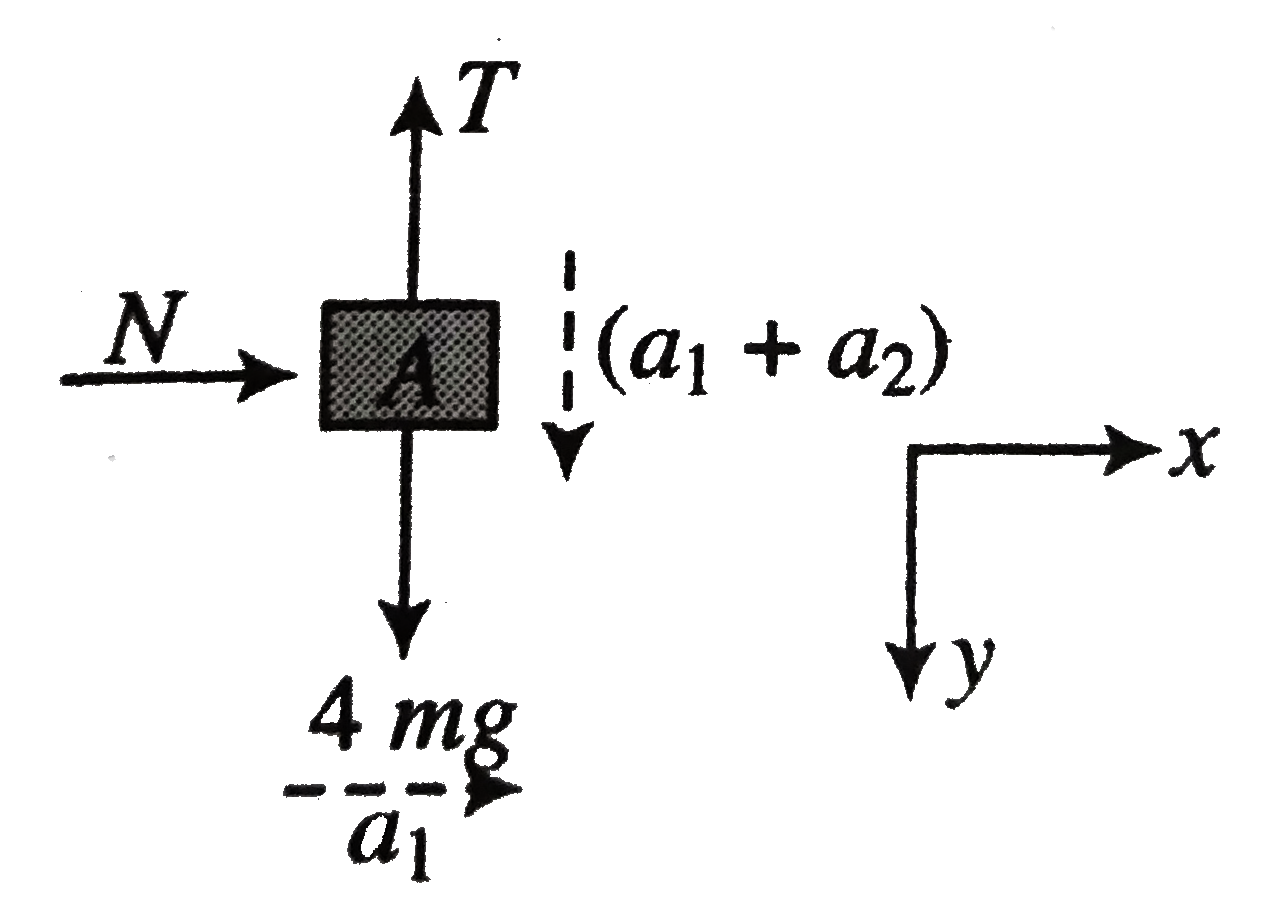
Using ΣFx=max and ΣFy=may, we get
N=4m(a1) ..(i)
and 4mg−T=4m(a1+a2) ..(ii)
Free bocy diagram of B (showing horizontal force only) is shown in the figure.
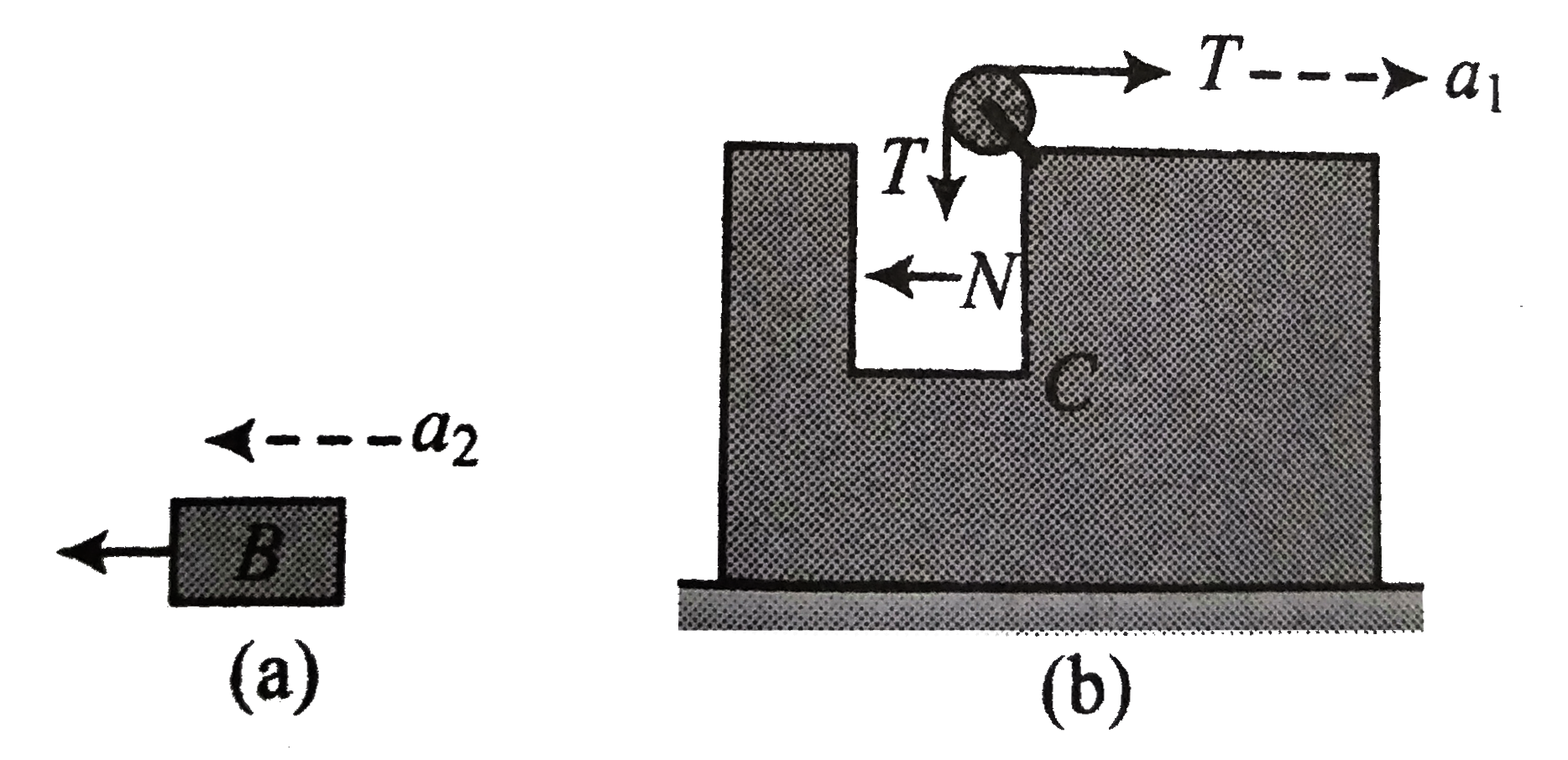
Using ΣFx=max, we get
T=3ma2 ...(iii)
Free body diagram of C (showing horizontal force only) is shown in fig.
Using ΣFx=max, we get
T−N=8ma1...(iv)
We have four unknowns T,N,a1, and a2. solving these four equations, we get
a1=g8 and a2=g2, a1+a2=58g
Thus, acceleration of A is g/8 in horizontal direction and 5g/8 in vertical direction.
Acceleration of B is g/2 in horizontal direction (leftwards) and acceleration of C is g//8 in horizontal direction (rightwards).
Topper's Solved these Questions
- NEWTON'S LAWS OF MOTION 1Book:CENGAGE PHYSICS ENGLISHChapter:NEWTON'S LAWS OF MOTION 1Exercise:Integer
Explore 5 Videos
- NEWTON'S LAWS OF MOTION 1Book:CENGAGE PHYSICS ENGLISHChapter:NEWTON'S LAWS OF MOTION 1Exercise:Assertion-reasoning
Explore 15 Videos
- MISCELLANEOUS VOLUME 2Book:CENGAGE PHYSICS ENGLISHChapter:MISCELLANEOUS VOLUME 2Exercise:INTEGER_TYPE
Explore 10 Videos
- NEWTON'S LAWS OF MOTION 2Book:CENGAGE PHYSICS ENGLISHChapter:NEWTON'S LAWS OF MOTION 2Exercise:Integer type
Explore 1 Video
Similar Questions
A block is placed on an inclined plane moving towards right horizontally with an acceleration a0=g. The length of the plane AC=1m. Friction is absent everywhere. Find the time taken (in seconds) by the block to reach from C to A.
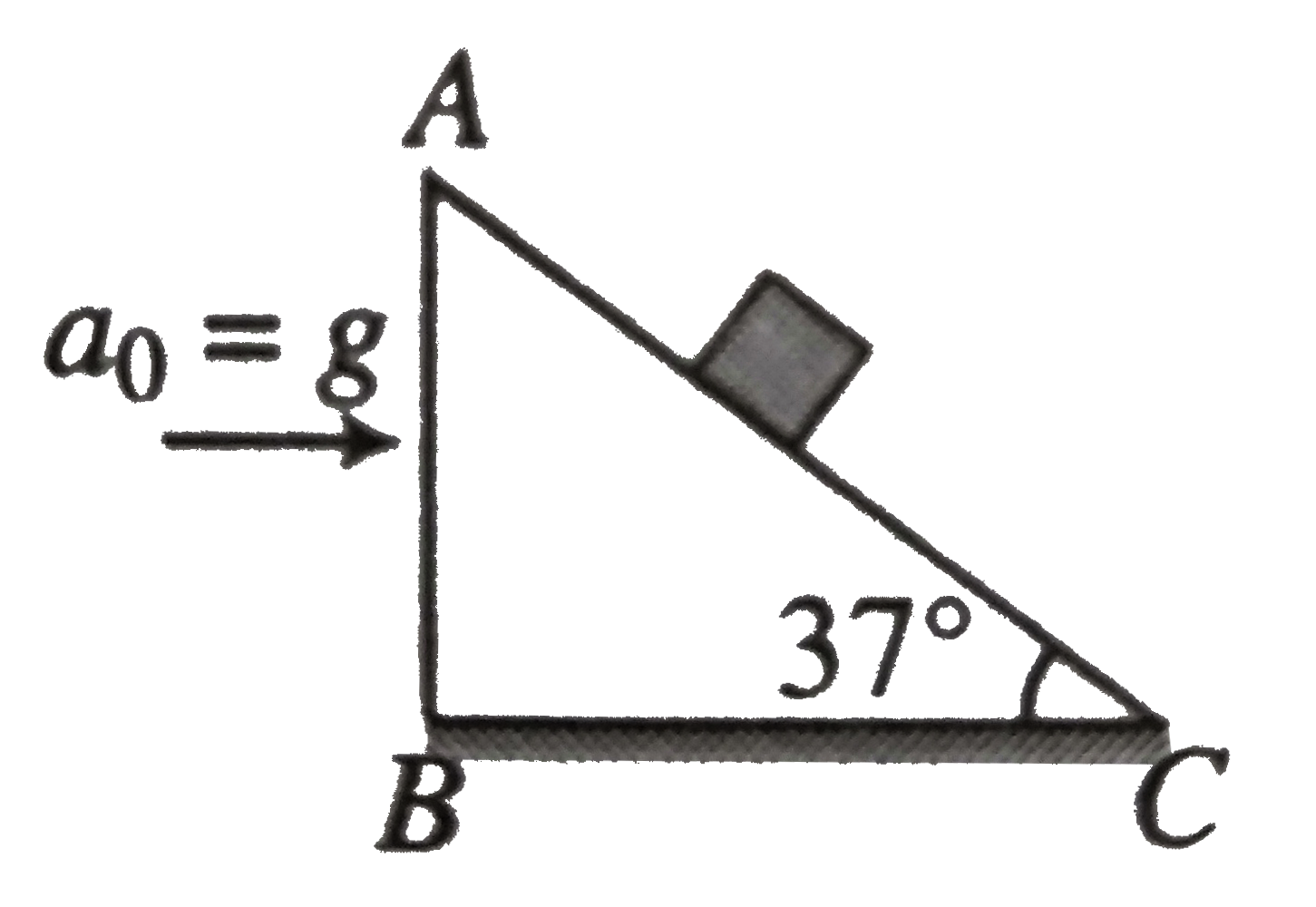
View SolutionStatement I: The driver of a moving car sees a wall in front of him. To avoid collision, he should apply brakes rather than taking a turn away from the wall.
Statement II: Frictional force is needed to stop the car or taking a turn on a horizontal road.
View SolutionTwo blocks are arranged as shown in figure. Find the ratio of a1/a2. (a1 is acceleration of m1 and a2 that of m2)
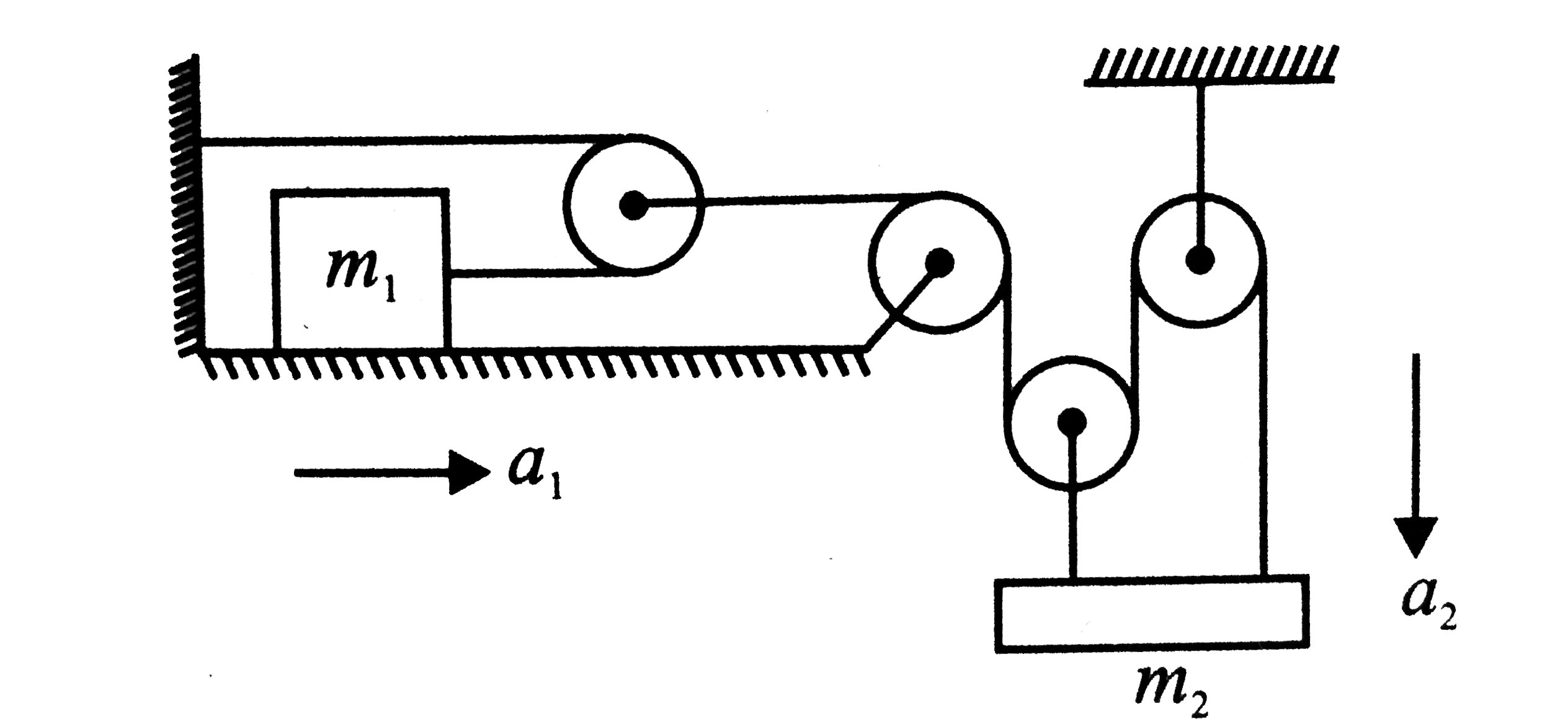
View SolutionA block is moving on an inclined plane making an angle 45∘ with the horizontal and the coefficient of friction is μ. The force required to just push it up the inclined plane is 3 times the force required to just prevent it from sliding down. If we define N=10μ, then N is
View SolutionTwo blocks A and B of equal masses are attached to a string passing over a smooth pulley fixed to a wedge as shown in figure. Find the magnitude of acceleration of centre of mass of the two blocks when they are released from rest. Neglect friction.
View SolutionTwo blocks A and B , each of mass 10 kg , are connected by a light string passing over a smooth pulley as shown in the figure. Block A will remain at rest if the friction on it is
View SolutionThree blocks A,B and C of mass 10 kg each are hanging on a string passing over a fixed frictionless pulley as shown in figure. The tension in the string connecting blocks B and C is (g=10m//s^(2))
View SolutionThree blocks A, B and C havig masses m kg, 2kg and 3 kg are attached by massless strings and ideal pulleys as shown in the figure. When the system is realeased from rest if the block A remains stationary. the mass of block A is
View SolutionTwo blocks of mass 2 kg and 5 kg are connected by an ideal string passing over a pulley. The block of mass 2 kg is free to slide on a surface inclined at an angle of 30^(@) with the horizontal whereas 5 kg block hangs freely. Find the acceleration of the system and the tension in the string. Given mu=0.30 .
View SolutionA small, light pulley is attached with a block C of mass 4 kg as shown in fig A block B of mass 1.5kg is placed on the top horizontal surface of C. Another block A of mass 2 kg is hanging from a string, attached with B and passing over the pulley. Taking g=10 ms^(-2) and neglecting friction, acceleration of block C when the system is released from rest is x//4 calculate x.
View SolutionTwo blocks A and B of respective masses 6 kg and 4 kg are connected with a string passing over a light friction less pulley as shown in the figure . The coefficient of friction between the block A and horizontal surface is 0.4 . Then the minimum mass of block C which should be placed over A to prevent it from moving is :
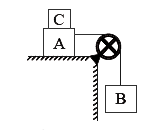
View SolutionTwo blocks of mass 2 kg and 5 kg are connected by an ideal string passing over a pulley. The block of mass 2 kg is free to slide on a surface inclined at an angle of 30∘ with the horizontal whereas 5 kg block hangs freely. Find the acceleration of the system and the tension in the string.
View SolutionTwo blocks of mass 2 kg and 5 kg are connected by an ideal string passing over a pulley. The block of mass 2 kg is free to slide on a surface inclined at an angle of 30^@ with the horizontal whereas 5 kg block hangs freely. Find the acceleration of the system and the tension in the string.
View SolutionA block of mass m_(1)=2 kg is kept on a smooth horizontal table. Another block of mass m_(2)=1 kg is connected to m_(1) by a light inextensible string passing over a smooth pulley as shown in the figure. If the blocks are released, what will be the (a) acceleration of each block (b) tension in the string?
View SolutionTwo blocks of masses 2 kg and 4 kg are connected by a light string passing over a light smooth pulley clamped to the edge of a horizontal table. The 2 kg block is on the smooth horizontal table and the other block is hanging vertically, (i) Find the acceleration of the stem if it is released from rest, (ii) Find the tension in the string.
View SolutionTwo blocks of masses 2 kg and 4 kg are connected by a light string passing over a light smooth pulley clamped to the edge of a horizontal table. The 2 kg block is on the smooth horizontal table and the other block is hanging vertically. (i) Find the acceleration of the stem if it is released from rest. (ii) Find the tension in the string.
View Solution
